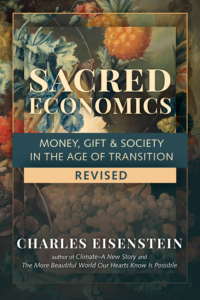Climate — A New Story
Chapters
Chapter 8: Regeneration
Healing the Water
In the carbon-centric climate narrative, ecological healing efforts that do not directly sequester carbon receive little attention. That must change if, as I have argued, water is as important or more important than carbon in maintaining climate equilibrium.
To be sure, all of the regenerative agriculture practices I’ve described bear huge benefits for the water cycle. In contrast to Brown’s Ranch with its eight-inch-per-hour absorptive capacity, on conventionally farmed land most of the water from heavy rains either runs off (carrying topsoil with it) or forms puddles on the ground that quickly evaporate. Then the water never recharges the aquifers.
As a general rule, what is good for the soil is good for the water. Hydrological health is a happy side effect of soil health.
There are also practices designed with the explicit purpose of restoring water health, for which building soil may be the happy side effect. These practices are especially significant in desertifying areas, where they are stopping and even reversing the process of desertification.
India is among the countries most vulnerable to water scarcity. Heavy use of groundwater for irrigation has led to plummeting water tables and dried-up wells. The solution, typically, is to dig deeper wells—a patently myopic response. But in Rajasthan, Rajendra Singh, known popularly as the “waterman of India,” has inspired a movement to implement low-tech water retention structures, reviving a technology thousands of years old. These structures include johads, which store water for future use in a way that also allows it to slowly permeate into the ground, earthen dams to create small reservoirs, and check dams to slow runoff after heavy rains and allow greater penetration into the water table. His work ignites a “virtuous circle”: greater water availability leading to more vegetation, leading to less soil erosion, leading to more water penetration, leading to more groundwater availability. Farming also becomes more productive, so that like the soil, the rural population no longer runs off to the cities. More local labor means more capacity to maintain the johads and dams. Singh’s ideas have been implemented in over a thousand villages, which maintain thousands of water retention projects and have planted millions of trees. Five dormant rivers in the region have come back to life and flow year-round.[19]
A related concept to Singh’s work is the “water retention landscape,” which uses terraces, berms, swales, and ponds to catch water during the rainy season so that it soaks into the water table instead of running off. My first encounter with water retention landscapes was at the Tamera Ecovillage in southern Portugal, a desertifying region where streams that once flowed year-round now flow only seasonally. Arriving at Tamera after several hours of driving through dusty, brown landscapes, I was stunned by an explosion of green. Fruit trees, gardens, and forests surrounded several ponds and small lakes—this in the middle of a drought-stricken summer. My first suspicion was that they had been pumping out groundwater. No, it had accumulated from last winter’s rains, held in the lakes by earthen dams. My second suspicion was that this community (whose majority are German expatriates) had arrogantly engineered and dominated the landscape. “How did you decide where to put the lakes?” I asked. They replied that they closely observed the land for several years until they understood where the water wanted to be. This attitude exemplifies the intimate relationship with the natural world that must come prior to any system of methods or practices.
Water retention slows the process of rain returning to the sea, so that it completes what the brilliant and controversial Austrian scientist Viktor Schauberger called the “full water cycle.” In the half water cycle, water evaporates from the ocean, falls as rain over land, and flows into streams and eventually back to the ocean. In the full cycle, the rain sinks into the earth and spends anywhere from weeks to decades there before emerging from springs. Working in the early twentieth century, Schauberger was an early critic of deforestation, which he recognized as a culprit in truncating the full water cycle.
Water retention can be accomplished in urban areas as well, through permeable surfaces, tree planting, catchment basins, and household rainwater storage cisterns. Without such measures, cities can do tremendous damage to surrounding communities and ecosystems. Los Angeles sparked the infamous Water Wars of Southern California in 1913 when it began diverting the Sierra Nevada snowmelt, and continues to dominate the region’s water resources, spending a billion dollars a year to source water. Meanwhile, the city also spends half a billion dollars getting rid of water—through its stormwater system. Like many places, LA has both too much water and too little water, flood and drought. One naturally follows the other: floods and droughts are both consequences of low rainfall absorption. Water retention, also called “slow water,” can ameliorate both, turning both deserts and cities green again.
What is possible on ranches and cities is also possible on a gigantic scale. One of the most impressive desertification reversal projects is the Loess Plateau Watershed Rehabilitation Project in northern China, made famous by filmmaker John D. Liu. The loess plateau of this region was a cradle of civilization, exceeded only by Mesopotamia in its antiquity, and suffering a similar fate. According to Liu, by the year 1000 deforestation and unsustainable agricultural practices had reduced a lush land of forests and grasslands to a parched, eroded wasteland that looks like a desert even though it receives modest rainfall. That is because 95 percent of it runs off immediately, forming huge erosion gullies and giving the Yellow River its characteristic color.
The results of the rehabilitation project can be seen in Liu’s stunning before-and-after photographs—the land has literally come back to life. The change came through a huge investment of labor, money, and planning. Local residents were recruited in large numbers to build small earthen dams, terraces, and other water retention features. They planted trees, abandoned slopelands unsuitable for planting, and restricted the grazing of sheep and goats. Crucially, they closely participated in the planning of the project as well, and were given subsidies for their labor and granted land rights to restored areas. In the end, an area of 35,000 square kilometers (the size of Belgium) was restored at a cost of about half a billion dollars. The written word cannot do justice to the changes that transformed the landscape, but Liu’s film has inspired similar projects in Rwanda, Ethiopia, Jordan, and other countries.
These projects show what is possible when the collective human will is brought into alignment with Earth’s capacity to heal. It shows what is possible when we make a collective choice toward beauty rather than quantity. And here is the caveat—it does require will, an active choice. Otherwise, we will continue to slide in the direction of our inertia.
Is something like this possible globally? Is it practical? Realistic? No, if we accept the permanence of society as we know it. Yes, if we are prepared to let go of what had seemed unchangeable. A half billion dollars over ten years is nothing in comparison with, say, global military budgets, which total about 3,300 times that. Devoting just 10 percent of military spending to watershed restoration would fund 330 loess-sized projects. Earth is actually not asking very much of us.
All right, I admit it, that last sentence is a bit disingenuous. Earth is asking a lot of us. Earth is demanding a transformation of our civilization’s fundamental priorities. Earth is demanding that we see her as sacred. Earth is demanding that we see her as alive. Earth is demanding we reorder our civilization and all its institutions accordingly. Money, government, law, technology … all must change. That is why the ecological crisis is truly an initiation for humanity.
End Notes
[19] Ahmed (2015).






